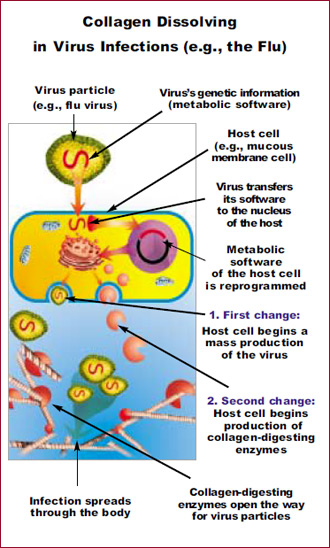 Dr. Rath’s breakthrough discoveries have wide implications which include, among others, defining new biological targets in developing effective natural approaches to controlling viral and bacterial infections. They stress an importance of connective tissue stability and integrity in our understanding of how infectious diseases spread in the body, and how specific micronutrients can protect and stabilize this biological barrier which is important in hindering infections.
Dr. Rath’s breakthrough discoveries have wide implications which include, among others, defining new biological targets in developing effective natural approaches to controlling viral and bacterial infections. They stress an importance of connective tissue stability and integrity in our understanding of how infectious diseases spread in the body, and how specific micronutrients can protect and stabilize this biological barrier which is important in hindering infections.
Cellular Medicine explains and proves that an optimum supply of specific micronutrients is critical in supporting various cellular functions that are essential for an effective immune response, a strong immune system and health. Micronutrients are needed for the thousands of biochemical reactions taking place in each cell of the body. They play a critical role in affecting the ability of the infectious agent to invade our body cells and multiply and in the proper functioning of the immune system. A chronic lack of specific micronutrients in our body’s cells weakens the immune system and makes us prone to infections and immune deficiency diseases. This cause can be eliminated through simple, safe, and effective means - including optimum nutrition and specific micronutrient supplementation.
Example: Cellular Medicine in viral infections
The body’s basic protection against viral invaders (such as the common flu, herpes, HIV/AIDS and many other viruses) is secured by the white blood cells (“police cells”). If an infection occurs in the body, monocytes travel to the source of infection. To reach the site that has been invaded by a virus, these infection-fighting cells must be able to move through connective tissue. To do this, monocytes secrete collagen-digesting enzymes that temporarily dissolve the surrounding connective tissue and pave the way to reach viral invaders at the site of infection. This process is strictly controlled so that it does not lead to permanent tissue destruction.
A virus consists only of software (genetic information), therefore it cannot reproduce without using specific biological machinery present in every living cell for its own purpose. As soon as the virus has invaded the host cell, it incorporates its genetic information into the nucleus of the host and starts using it for its own growth and spread. The following two key steps occur in the virus infection process:
Step 1: Multiplication of the Virus
The metabolic production system of the host cell receives biological signals to multiply the virus particles. After multiple reproduction cycles, virus particles are released by the host cell into the surrounding area where the newly made viruses can invade new cells.
Step 2: Mass Production of Collagen-Dissolving Enzymes
The virus also sends biological signals to the host cell to produce and secrete collagen-digesting enzymes. The collagen-digesting enzymes then start dissolving the surrounding tissue. With the help of these enzymes the infection then can spread easily to other parts of the body. The more a virus is capable of using the metabolism of a host cell for these two purposes, the faster a virus infection will spread and the sicker a patient will feel.
Strengthening and preserving the integrity of the connective tissue surrounding all cells in our body is important in combating infectious diseases caused by viruses (i.e., the flu, herpes and HIV/AIDS). This can be achieved by supporting the production of collagen and other connective tissue components and by inhibiting the activity of connective tissue degrading enzymes. Natural substances such as lysine, in connection with optimum supplementation with vitamin C and other micronutrients, can stop or slow down the aggressive spread of an infection and provide additional health benefits.
This same collagen-dissolving mechanism plays an important role in a variety of infectious diseases, such as those caused by bacteria or parasites. Without the disruption of the surrounding connective tissue, the agents that cause diseases (viruses and bacteria) cannot invade the body and spread.